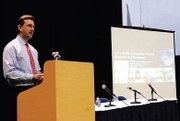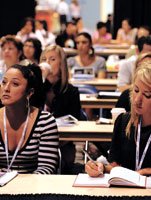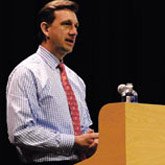Get Smart
As companies limit trade show travel, organizers respond with education programs to help executives work smarter and seminars focusing on today’s hot-button topics
The tight economy has forced companies to pare down the number of people they send to trade shows and to shorten the length of time they stay at these events. The good news is the people walking the aisles tend to be decision makers. The bad news is they are hard-pressed for time as they try to do more work in a shorter period.
But the challenges of the current economic conditions and the ongoing global expansion of the apparel industry mean that the need for education is higher than ever at trade events, according to show producers. In addition, emerging regulatory issues pertaining to trade and consumer products have also pushed up demand.
In the past 18 months, show producers have stepped up the emphasis on educational programs at their events, bringing bigger names and more-pertinent subject matter to the table. While it is difficult to gauge whether this move has helped to boost attendance at trade shows, producers said they are seeing capacity crowds turn out for their seminars.
In the age of the new Consumer Product Safety Improvement Act (CPSIA), which mandates testing all children’s products for lead content, and 10+2, an importer compliance measure, there has been an increasing hunger for education, said Tim von Gal, president of the Material World & Technology Show, held annually in Miami Beach, Fla., and soon to bow in Los Angeles.
In addition, the recessionary economy has retailers and manufacturers on the defensive. One way to fight is with knowledge about how to sell better and save money and lead time.
“I’m seeing more panel discussions than ever,” noted Frances Harder, executive director of Los Angeles–based trade agency Fashion Business Inc. Harder headed a panel at the recent GlobalTex textile and sourcing show in Los Angeles and helps run dozens of workshops at the FBI headquarters in Los Angeles.
“The [shows and seminars] help them, and both sides are grateful for the information and knowledge they gain,” she said. “People are eager for interaction and obtaining feedback.”
The debut of GlobalTex saw educational events that were packed, according to Alden Clanahan, vice president of special events and visual design for the show.
“We were thrilled about the attendance,” Clanahan said. “We did a lot of research early on, visiting shows like Premiegrave;re Vision and TexWorld and partnering with the right organizations like FBI, [Textile Association of Los Angeles, the California Fashion Association] and others.”
Some of the networking discussions were scheduled either early with breakfast or later in the day with cocktails to give show goers ample time to visit the booths, as well. CPSIA and 10+2 were on the agenda at a pair of evening seminars conducted by CFA President Ilse Metchek. FBI’s Harder presented sessions on technology and business practices during luncheons. The educational events drew executives from Karen Kane, Nordstrom (private label), Disneyland Resort, Guess? and 7 For All Mankind, among others.
GlobalTex’s alignment with key organizations helped solidify the seminar schedule. Likewise, Material World partnered with the American Apparel & Footwear Association (AAFA), giving the sourcing, fabric and technology trade show an advantage in putting on seminars.
“The AAFA is on top of legislative issues and provides up-to-the-minute updates on major topics. That gives our shows a unique advantage,” von Gal said.
Material World and GlobalTex looked to balance their seminar schedules, providing both macro and micro views of issues. One of the more popular events during last month’s Material World was a presentation by Susan Power on sourcing and manufacturing for smaller businesses. A presentation by IBM on the current state of business also drew a strong audience. GlobalTex brought in big French trend forecasters as well as local houses such as Design Options in Los Angeles to provide different perspectives.
Shifting focus
During these critical times, show producers have also been pushing for more objectivity during educational events and less of the “infomercial” approach sometimes found at seminars.
The case-study presentations at Material World’s recent shows have been driven from the customer side rather than from the vendor’s view. That has helped to improve the credibility of the educational events, and the profile of seminar attendees has increased as a result.
“You see a lot of the principals, chief information officers, presidents—the important decision makers—attending these events,” von Gal said.
Material World show producer Urban Expositions is also working on providing high quality at its new Los Angeles show, to be held Sept. 30–Oct. 2 at the California Market Center, where it will coordinate with the Los Angeles International Textile Show’s seminar schedule.
Clanahan agreed that substantive subject matter is important in the current economic climate.
“They walk away and take back this information to share with colleagues and implement these ideas,” he said.
Thomas G. Travis, managing partner of Sandler, Travis & Rosenberg P.A., is a frequent speaker at shows such as the MAGIC Marketplace. He often addresses global tariff and trade issues. His firm also produces more than 200 seminars a year around the world.
“We’ve become very focused on particular subject matters. The response has been very good,” he said.
Because of travel and economic constraints, Travis’ company has been doing more Webinars. He said he plans to speak at the upcoming MAGIC show, but he noted that the trade shows will continue to face challenges.
“The ones that are surviving are persevering,” he said. “They’re cutting back from four days to three days or three days to two days. People are acting smart to change.”
Chris DeMoulin, MAGIC International’s president and the executive vice president of Advanstar’s Fashion Group, said that despite retailers’ tight schedules, seminar attendance has been mostly at capacity during recent shows. Many are at the standing-room-only point, he said, adding that that’s not out of the ordinary.
“MAGIC mirrors what is important to the fashion industry,” he said. “The economy is certainly on people’s minds, and they are looking for ways to navigate. We offer expert advice on a wide variety of topics: the new economy, trending, marketing initiatives and social networking, how to build a business, and going green.”
Recent topics have addressed the shifting economy, becoming more efficient in planning marketing and advertising, and the “Obama effect” on business.
DeMoulin pointed out that the show’s layout, with seminar venues and the show floor under one roof, makes navigation easy for buyers. Several European shows require visitors to travel to an outside location, he said.
“The level of convenience at MAGIC is more important than ever, as everyone is watching the bottom line,” he said. “Our seminars offer education and information from experts, as well as face time with industry leaders. The seminars are one more layer to the full MAGIC experience.”
























